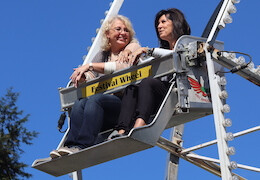The Southern Wesleyan Editorial Style Guide was created by the Office of Communications as a quick reference tool to help university communicators follow a style that is consistent and appropriate for print and electronic materials written for and about Southern Wesleyan University.
It was created to give the writers and editors of promotional and marketing materials answers to questions about style and usage. It does not attempt to address the style for other kinds of writing (academic papers, memorandums, personal correspondence, etc.).
The style points raised in the Editorial Style Guide are guidelines, not rules chiseled in stone. Each guideline must be applied to each case and the judgment of the writers and editors is a part of that application. The guiding principle in applying any style is that it is most important to maintain a consistent editorial approach within a specific piece.
Last revised on May 17, 2019
Academic Degrees
Do not use periods in abbreviations of academic degrees. Add an "s" to express in plural.
AA, AS, BS, BFA, MA, MBA, MD, JD, PhD, LLD, MBAs, MDs
Set off with commas when used with names.
Conference presenters were John Doe, MD, and Jane Doe, PhD.
Names of degrees should be lowercase when used in a sentence.
John Doe holds a bachelor of arts in chemistry from Oxford University. He also earned his MA in biochemistry from Yale. Please note that proper nouns, such as "English" and the "Bible" are always capitalized.
Academic Year/Term
Lowercase season and use full year in formal contexts.
spring term 2019
spring '19
Academic Disciplines
Only capitalize a discipline when it is a proper noun. (See also departments, offices, and programs entry.)
She is a scholar of English literature. He is a Bible scholar.
She is an astronomy professor.
Acronyms and Initialism
On first use, spell out the full name of an organization or entity unless it is most widely known by its abbreviated name (SAT, NASA, IBM). If you reference the organization or entity more than once, follow the initial spelled-out form with the acronym in parentheses and use the acronym for subsequent references. Do not use periods between letters.
He was packing for the Southern Wesleyan Outdoor Orientation Program (SWOOP). The SWOOP backpacking trip began in two days.
Alumni
Everyone who matriculates at Southern Wesleyan, whether a graduate or not, becomes an alumna or alumnus of the university. Correct usage is as follows:
alumna (feminine, singular), alumnae (feminine, plural), alumnus (masculine, singular), alumni (masculine, plural, or mixed gender group)
Do not use "alum."
Campus and Education Centers
The Southern Wesleyan University campus in Central, South Carolina, can be referred to as the "main campus" or "Central campus." Although they are no longer in existence, an article might refer to the university's education centers (Central, Charleston, Columbia, Greenville, North Augusta) in articles, etc. of a historical nature. In that case, they were known as education centers.
Centuries and Decades
Use ordinal numbers to express all centuries except the first through ninth centuries.
21st century, 12th century, third century
Formal style for decades is to use all four digits of the year followed by an "s." Informal permits substitution of apostrophe for the first two digits unless confusion could result.
the 1970s, the '60s
Comma
We recommend using the serial comma if needed for clarity.
She was carrying textbooks about botany, anatomy and physiology, and astronomy.
Use a comma before a conjunction that joins two independent clauses.
The exhibit will open on Friday, and curators will be available to answer questions.
Composition Titles
Titles of books, movies, songs, works of art, etc., should be placed in quotes. Style for writing news articles generally avoids italicizing.
This applies to books, journals, pamphlets, periodicals, newspapers, epic poems, plays, movies, television and radio programs, operas, oratorios, performances, long musical compositions, album names, paintings, drawings, statues, cartoons, and comic strips.
Names/titles that are capitalized and set within quotation marks include:
journal articles, book chapter titles, essays, poems, theses, PhD dissertations, unpublished book manuscript, television series episodes, songs, photographs, lectures, symposia, seminars, exhibitions, conferences, courses
Days and Dates
Capitalize and spell out days of the week.
Capitalize the names of months.
When a month is used with a specific date, abbreviate only Jan., Feb., Aug., Sept., Oct., Nov. and Dec. Spell out when using alone or with a year alone.
Jan. 14, 2019
January 2019
Do not add th, nd, rd or st after a date.
The event is scheduled for Monday, June 10. When month, date and year are used within a sentence, use commas:
This event will take place Sept. 24, 2020, at the square.
Departments, Offices, and Programs
In most instances, capitalize only the full, proper names of departments, offices, programs, and institutions. In general, do not capitalize shortened names. Generic terms referring to a properly named entity are lowercased.
the Office of Admissions, admissions office
Southern Wesleyan University, the university
the Division of Social Science, social science
Internet Terms
There’s no question that the Internet has had a profound impact on the English language, adding many, many words to our vocabulary in a short period of time. Although grammarians and style guides are slow to catch up to the general public's usage, here are our current guidelines to some common Internet terms.
email (NOT e-mail)
Internet (capitalized)
online (NOT on-line)
World Wide Web / Web (capitalized)
website / web page / webcast (not capitalized)
Job Titles
Capitalize a person's title when it immediately precedes a person's name. A title is lowercased when it follows a name or is used in place of a name.
Director of Athletics John Doe was thrilled with the championship victory.
Jane Doe, executive director of alumni relations, scheduled the meeting.
Name Usage
Use “Southern Wesleyan University” as the title of the university. After the first reference, the name may be shortened to SWU, all caps. Using “Southern Wesleyan” in subsequent references is also acceptable.
SWU facilities:
Use the following when writing the names of these university facilities:
Alive Chapel
Alumni Center
Brower Classroom Building
Bryant Lodge
Clayton Welcome Center
Correll Hall
Ellenburg Lecture Hall
Folger Fine Arts Auditorium
Freedom's Hill Church
Gibson Science Building
Jennings Campus Life Center
Newby Education Center
Newton Hobson Chapel and Fine Arts Center
Newton Hobson Chapel and Fine Arts Center Auditorium
Nicholson-Mitchell Christian Ministry Center
Physical Plant
President's Home
Rickman Library
Sheriff National Guard Memorial Flag Plaza
Terry Hall
Terry Hall Annex
Tysinger Athletic Center
University Dining Commons - The Founders (or “The Founders, located on the lower level of the University Dining Commons”)
Recreational Areas:
M.L. Atcheson Putting Green
Dr. Keith Connor Baseball Field or Connor Field
Childs Soccer Field or Childs Field
Varsity Field – Softball
Joe R. Gilbert Track and Field
P.B. Wood Golf Practice Range
Campus Housing:
Campus Apartments
Childs Hall
Eagles Rest Bed and Breakfast
Joiner-Hilson Complex
Mullinax Hall
Rickman Apartments
Stuart-Bennett Hall
West Residence Hall
University departments and divisions are correctly identified on the university’s website, as are academic degrees (see also “Degrees” below).
College of Arts and Sciences
- Division of Fine Arts
- Division of Humanities
- Division of Religion
- Division of Science
- Division of Social Science
Benson School of Business
School of Education
Numbers
In general, spell out (use words for) numbers one through nine and use numerals for 10 and above.
There are seven key points in the argument.
The class had 32 students in attendance.
Also, spell out nonspecific (or casual) references to numbers, numbers in quoted speech, and numbers beginning a sentence.
There are a million reasons to disagree with your argument.
Forty-six students attended her lecture.
"We are excited to offer twelve events this spring, " said John Doe.
Be consistent in styling when two or more numbers apply to the same category in a paragraph or series.
There are 20 sections to Dante's work: 15 are set in the first sequence and 5 in the latter.
Use a combination of numerals and words to express very large numbers.
We received a $24 million gift.
It has a population of 36 million.
On-Campus and Online
SWU offers educational programs in both on-campus and online modalities. We refer to these as on-campus programs and online programs. The online programs and services at SWU are combined under the sub-brand of "SWU Online." The following are outdated terms for on-campus or online programs and should not be used when referring to SWU's current educational offerings:
- Traditional Program
- Traditional Campus Program
- Adult and Online Programs
- Adult and Graduate Programs
- Adult and Graduate Studies (AGS)
- Leadership Education for Adult Professionals (LEAP)
Percentages
It is now acceptable to use the percentage symbol with numerals, for example: 50%.
Periods
Use one space after a period before starting another sentence.
Quotations / Quotation Marks
Set speech verbs in the present tense unless quotation is from an identified, fixed event in the past, such as a speech.
"Athletics are expanding and moving forward," Doe says.
"Athletics are expanding and moving forward," said John Doe in his 2012 banquet speech.
Commas and periods are always set inside the quotation marks. Colons and semicolons are always set outside of quotation marks. Exclamation or question marks fall inside of quotation marks only when they are part of quoted material. Commas should never be used in combination with exclamation or question marks.
Southern Wesleyan University
Use full name (Southern Wesleyan University) on first reference when writing for an external audience. After the first reference, the name can be shortened to "SWU" or "Southern Wesleyan."
State Names
Spell out state names when they stand alone in running text. Use abbreviated forms (not postal code) for state names with a city. When using city and state, use a comma before and after state name. Use two-letter postal code state abrreviations in a context where a zip code follows state name. Do not abbreviate Alaska, Hawaii, Idaho, Iowa, Maine, Ohio, or Utah.
Ala., Ariz., Ark., Calif., Colo., Conn., Del., Fla., Ga., Ill., Ind., Kan., Ky., La., Mass., Md., Mich., Minn., Miss., Mo., Mont., N.C., N.D., N.H., N.J., N.M, N.Y., Neb., Nev., Okla., Ore., Pa., R.I., S.C., S.D., Tenn., Tex., Va., Vt., W.Va., Wash., Wis., Wyo.
Time of Day
Use "a.m." and "p.m." (lowercase with periods). The terms "noon" and "midnight" are acceptable.



